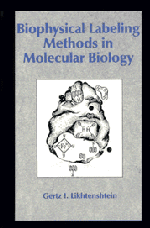Book contents
- Frontmatter
- Contents
- Preface
- Abbreviations
- 1 The method of spin labeling
- 2 Double-labeling techniques
- 3 Fluorescent labeling methods
- 4 Triplet labeling methods
- 5 Mössbauer spectroscopy, electron scattering, and other labeling methods
- 6 Studies of proteins and enzymes: structure, dynamics, and mechanism of action
- 7 Structure and dynamics of membranes
- 8 Nucleic acids and other biological systems: biological assays
- Conclusion
- References
- Index
1 - The method of spin labeling
Published online by Cambridge University Press: 29 January 2010
- Frontmatter
- Contents
- Preface
- Abbreviations
- 1 The method of spin labeling
- 2 Double-labeling techniques
- 3 Fluorescent labeling methods
- 4 Triplet labeling methods
- 5 Mössbauer spectroscopy, electron scattering, and other labeling methods
- 6 Studies of proteins and enzymes: structure, dynamics, and mechanism of action
- 7 Structure and dynamics of membranes
- 8 Nucleic acids and other biological systems: biological assays
- Conclusion
- References
- Index
Summary
Introduction
At present there probably is no biophysical method that has spread so fast and so widely as spin labeling. This method is based on a combination of the unique physical and chemical properties of nitroxide radicals (NRs).
Among the myriad compounds that are products of modern organic chemistry there is hardly a class of substances that could have so diverse and unexpected applications as do NRs: they are used as “molecular rulers” to measure the distances between paramagnetic centers, the sizes and shapes of grooves and slits in the enzyme active centers, and the depth of the center immersion into the biological matrix. NRs can serve as specific microscopic seismic stations to monitor the finest changes in the microrelief of biological objects and conformational waves at their functioning. Radicals may be used to probe the rigidity and mobility of certain portions of enzymes, membranes, and other objects and to study the conformational dynamics of the macromolecular shape, i.e., the macromolecule's “breath.” They help in the study of the spatial distributions of certain substances, e.g., water, nitroxides, dioxygen, etc. (ESR tomography).
In many other cases, when a local microscopic property (e.g., dielectric constant, donor–acceptor capacity, strength of the electric or magnetic field, redox ability, hydrogen ion concentration, delocalization of spin density and electron density) should be measured in a given portion of a biological object, NRs may serve as efficient tools.
The majority of spin labels and probes are stable and compact compounds that contain a nitroxide fragment (Figure 1.1), producing distinct and intensive signals of electron spin resonance (ESR).
- Type
- Chapter
- Information
- Biophysical Labeling Methods in Molecular Biology , pp. 1 - 45Publisher: Cambridge University PressPrint publication year: 1993
- 1
- Cited by



